This post will teach you how to make a beginner sourdough starter at home, step-by-step. All you need is flour, water and a little bit of patience. Before you know it, you’ll have your very own bubbly, active starter ready to make THE BEST sourdough bread, sourdough focaccia, homemade sourdough pizza crust and much more!
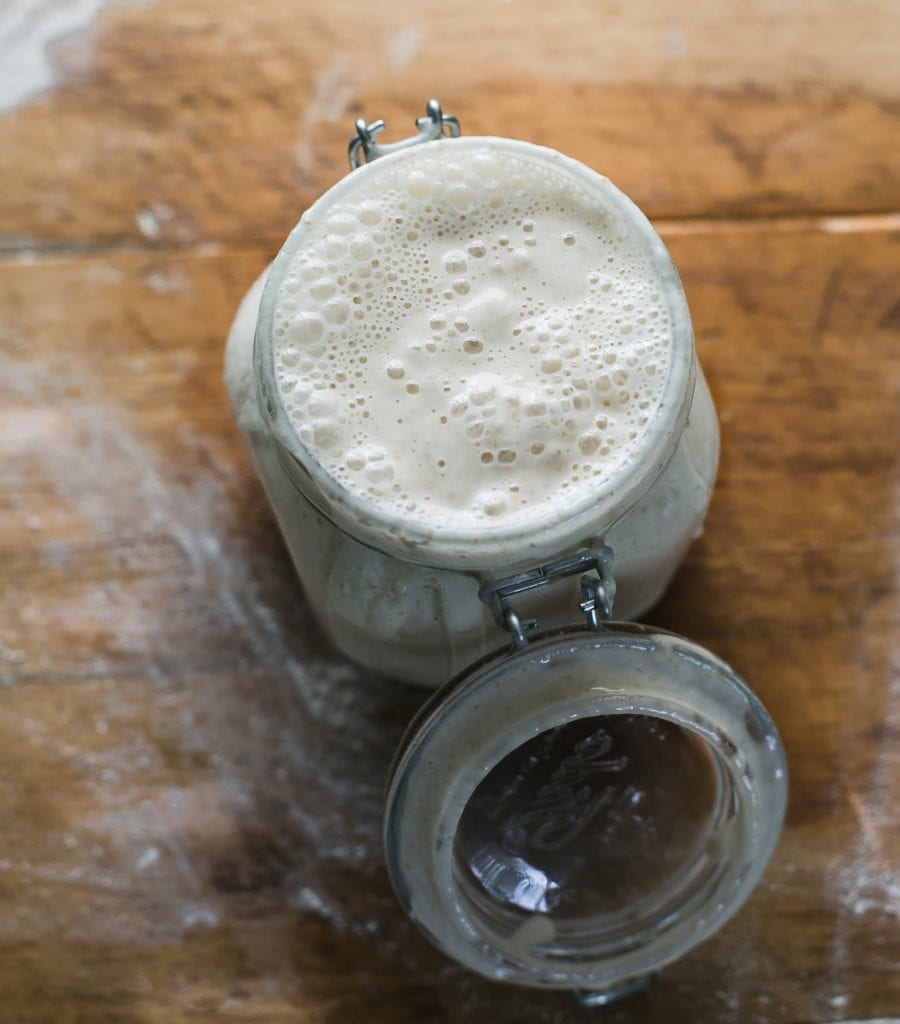
Looking to bake incredible sourdough bread? First: you’ll need a sourdough starter. Without it, your bread won’t rise. It’s the absolute heart and soul of sourdough baking. Creating one from scratch is not hard to do. However, the process can seem intimidating (especially for beginners). Let’s change that. Adapted from my bestselling book Artisan Sourdough Made Simple, I will demystify and simplify the process with step-by-step instructions.
Once your starter is established, it can be used for a wide variety of sourdough bread recipes including this scrumptious sourdough bread with olive oil (most popular recipe on my blog!), my sourdough focaccia, sourdough pizza crust, sourdough sandwich bread and soft sourdough cinnamon rolls to name a few!
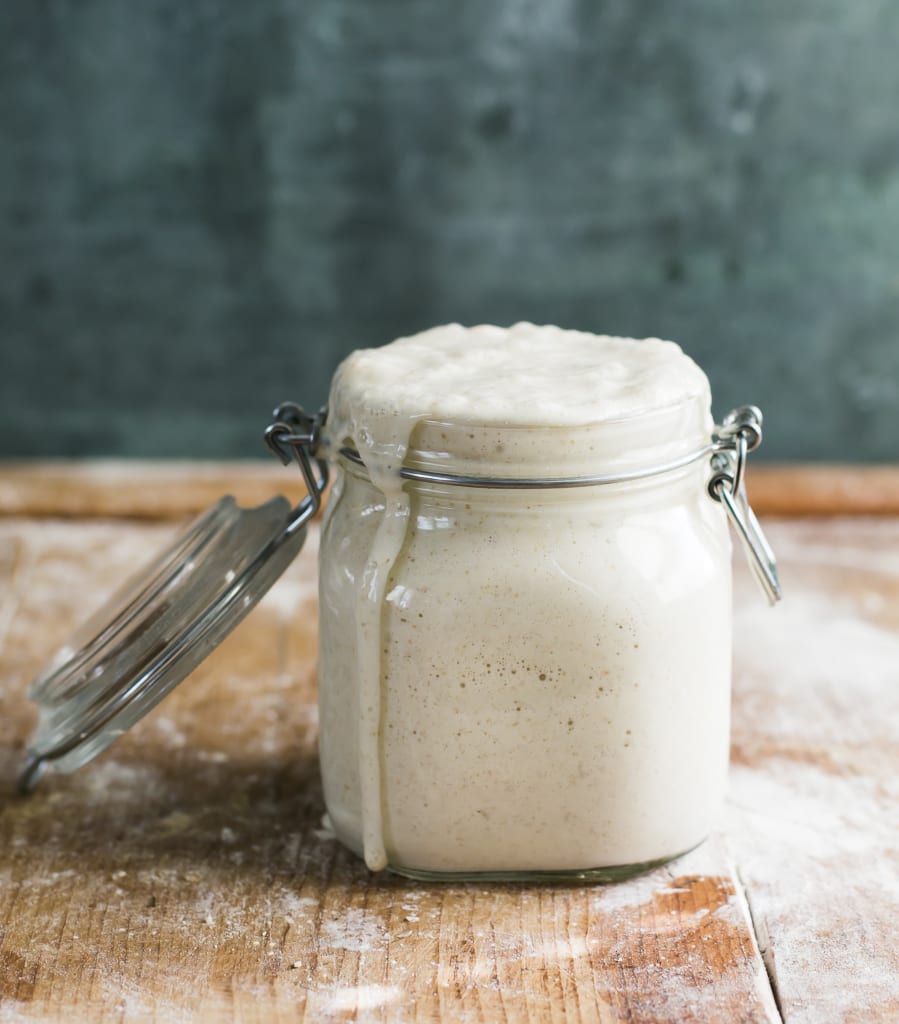
What is a Sourdough Starter?
Sourdough is more than just a recipe; it’s an understanding. So before we dive in, let’s define. Simply put: a sourdough starter is a live fermented culture of fresh flour and water. Once combined, the culture will begin to ferment and cultivate the natural yeasts found in our environment. A small portion is added to your bread dough to make it rise. Commercial yeast IS NOT required.
Sounds a bit weird, right? Of course it does. And it should. Know this: natural “wild” yeast is all around us. It can be found in a bag of flour, in the air, on your hands etc. Just because you can’t see it, doesn’t mean it’s not there and doing its thing. It’s like magic.
How Long Will It Take?
To create a sourdough starter from scratch, the overall process will take 7 days (or more) from start to finish. It’s not instant. First, you’ll create the starter with whole wheat flour to jumpstart fermentation. Then, you’ll continue to feed it with regular all purpose flour to cultivate the wild yeasts and friendly bacteria.
When Will it Be Ready To Use?
Your starter is ready to use when it has doubled in size, with plenty of bubbles on the surface and throughout the culture.
NOTE: It’s not uncommon for it to take up to two weeks or more for the starter to become active. It all depends. I know this timeframe sounds a bit vague, but growing yeast in a jar (that’s basically what you’re doing) can be unpredictable at times. Please be patient if the process takes time for you- it’s normal.
Is it Difficult to Do?
Absolutely not! In short: you’re basically adding flour and water to a jar, feeding it with more flour and water over time, and then waiting for it to become bubbly and double in size. That’s it. Most of your time involvement is hands-off. Can I ask you a favor though?
Don’t overthink it.
There’s a lot of sourdough information out there, and you will fall down a major rabbit hole if you start poking around. Just stick to this tutorial for now and follow the steps as written.
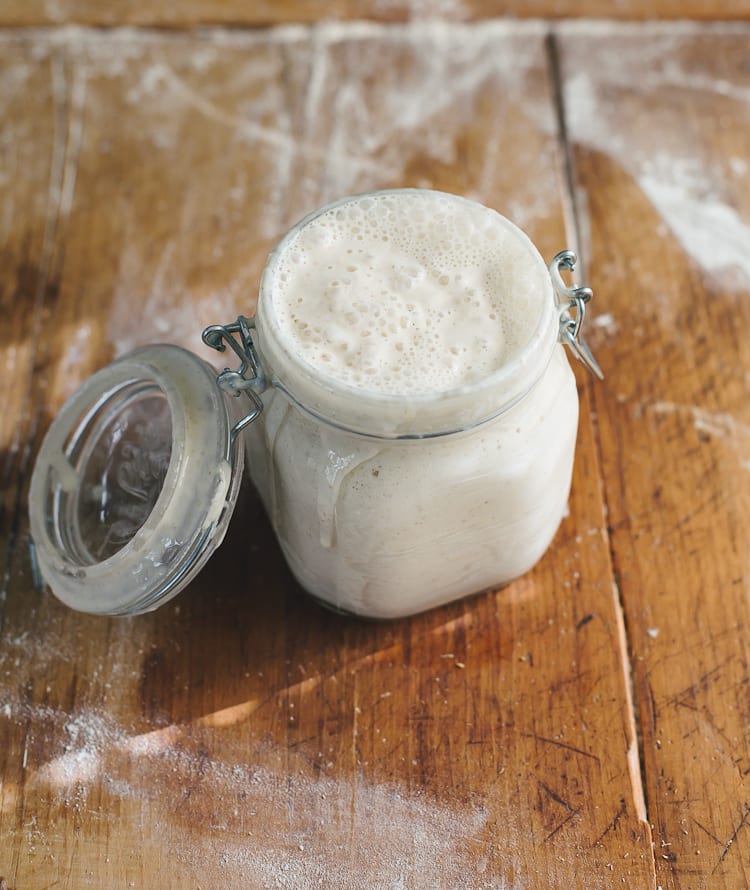
Beginner Sourdough Starter Recipe
You will Need:
Supplies
- 3/4 L jar (I use this one)
Ingredients
To create the starter:
- 60 g (1/2 cup) whole wheat flour
- 60 g (1/4 cup) water
To feed the starter each day (Day 3-7):
- 60 g (1/2 cup) unbleached all purpose flour or bread flour
- 60 g (1/4 cup) water
NOTE: Use regular, unbleached all purpose flour or bread flour for best results- skip organic. The enzymes are different which can hinder the rising process the first time around. I use either KAF, Trader Joe’s or Whole Foods. Filtered water or tap water is fine. Use the latter if you know it’s mostly chemical/chlorine free.
Day 1: Make the Starter
- Before you begin, establish a feeding schedule. In other words, feed your starter at the same time each day. This will establish consistency, which sourdough starters love. Consider feeding your starter in the morning when you wake up.
- Combine 60 g (1⁄2 cup) of whole wheat flour and 60 g (1⁄4 cup) of warm water in a large jar.
- Mix with a fork until smooth; the consistency will be thick and pasty. If measuring by volume, add more water to thin out the texture if needed. Cover with plastic wrap or a lid, and let it rest in a warm spot, about 75-80 F for 24 hours.
TIP: Looking for a warm spot? Place your starter on a cookie sheet inside the oven (turned off) with the light on for a few hours (but not overnight- it might become too warm). You can also use a proofing box set to your desired temperature, or a microwave with the door ajar and the light on.
Day 2: Got Bubbles?
- Today, you’re going to check if any small bubbles have appeared on the surface.
- Bubbles indicate fermentation, which is what you want! However, it’s okay if you don’t see anything right away; the bubbles might have appeared and dissolved overnight while you were sleeping. This happens quite often.
- You do not have to do anything else right now. It does not need any flour or water. Just rest the starter in your warm spot for another 24 hours.
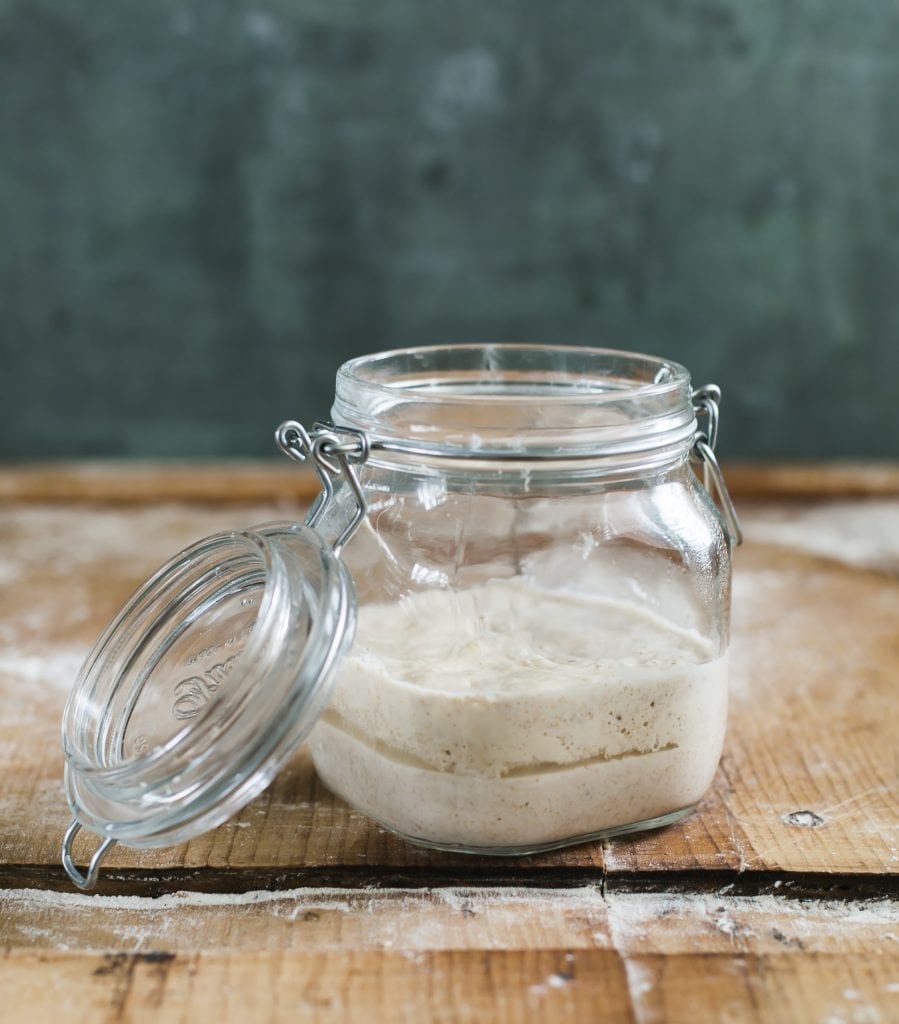
Day 2 (Con’t): What’s that brown liquid?
- During the creation process, and even after your starter has been established, a dark liquid might appear on the starter (the image above shows the liquid in the middle of the starter- it’s usually found on the surface).
- This liquid is called “hooch” and is an indication that your starter needs to be fed. It also has a very stinky smell, similar to rubbing alcohol or gym socks. This is normal. Don’t freak out. Any time you see this liquid, it’s best to pour it off, along with any discolored starter present. However, on Day 2 just leave the hooch alone; you can get rid of it tomorrow when you start the feedings.
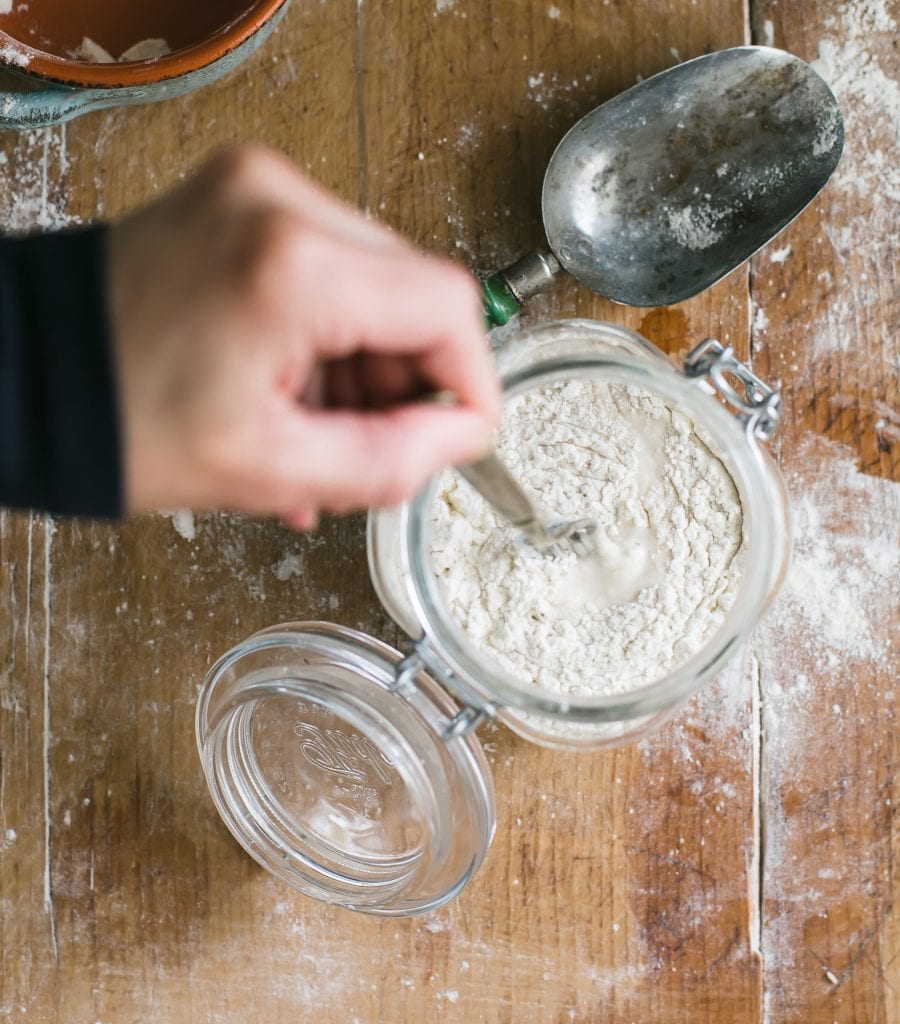
Day 3: Feed Your Starter
- Whether bubbles are visible or not, it’s time to start the ongoing feeding process.
- Remove and discard approximately half of your starter from the jar (you should have about 60 g left). Use a spoon. The texture will be very stretchy. Add 60 g (1⁄2 cup) of all-purpose our and 60 g (1/4 cup) of warm water. Mix with a fork until smooth.
- The texture should resemble thick pancake batter or plain yogurt at this point so add more water as needed. Cover and let rest in your warm spot for another 24 hours.
DAYS 4, 5, & 6: Keep on Feeding!
- Repeat the same feeding process as outlined on Day 3:
- Remove and discard half of the starter, and feed it with 60 g (1⁄2 cup) of all-purpose flour and 60 g (1/4 cup) of warm water. As the yeast begins to develop, your starter will rise, and bubbles will form on the surface and throughout the culture.
- When the starter falls, it’s time to feed it again.
TIP: Place a rubber band or piece of masking tape around the jar to measure the starter’s growth as it rises.
Day 7: A Sourdough Starter Is Born!
- By now, your sourdough starter should have doubled in size.
- You should see plenty of bubbles, both large and small. The texture will now be spongy, fluffy, and similar to roasted marshmallows (think: s’mores). It should also smell pleasant and not like stinky gym socks. If these conditions are met, your starter is now active.
- The very last step is to transfer your sourdough starter to a nice, clean jar. In keeping with tradition, you can also name it (and please do!). My starter is called Dillon after my oldest boy and it’s bright and bubbly, just like he is ;)
- Now you’re ready to bake! Start with my beginner sourdough bread recipe- you’re going to love it!
What’s Next? Let’s Make Bread!
- Sourdough Bread Recipe (reader favorite!)
- Beginner’s Guide to Sourdough Focaccia
- Best Sourdough Pizza Crust (No steel or stone!)
- Feeding Sourdough Starter: My Best Tips & Tricks
- Troubleshooting Your Sourdough Starter
A Few Tips for Ongoing Care…
So you’ve created a sourdough starter! Now what?
Just like any living creature, it must be kept alive with regular feedings to maintain its strength. If your starter is not strong, your bread will not rise. Caring for your starter is much easier than you’d think, and certainly won’t take hours of your time.
Note: You will need to feed your starter every time prior to making bread dough and to maintain it (keep it alive).
How to Feed a Sourdough Starter
Feeding Routine:
- Begin by removing and discarding about half of your starter.
- Replenish what’s left in the jar with fresh all purpose flour and water.
- Cover loosely, and let it rise at room temperature until bubbly and double in size. Once it falls, the bubbles will become frothy and eventually disappear. Then you’ll know it’s time to feed your starter again.
- Feed your starter everyday if it’s stored at room temperature. If you keep it in the fridge, feed it once a week.
PS: If you miss a feeding, don’t worry- your starter is not going to die. It might look ugly (and smell horrendous) but it usually just needs a few feedings to perk back up.
When is Your Sourdough Starter Ready To Use?
Your starter is ready when it shows all of the following signs:
- bulk growth to about double in size
- small and large bubbles on the surface and throughout the culture
- spongy or fluffy texture
- pleasant aroma (not reminiscent of nail polish remover/gym socks/rubbing alcohol)
If you’re having trouble spotting the signs, don’t forget to place a rubber band around the base of the jar to measure the starter’s growth.
You can also try the float test mentioned above: Drop a small dollop of starter into a glass of water. If it floats to the top, it’s ready to use.
How to Store Your Sourdough Starter
Once your starter is established, you have two storage options to consider.
At Room Temperature: If you bake often—let’s say a few times a week—store your starter at room temperature. This will speed up fermentation, making the starter bubbly, active, and ready to use faster. Room temperature starters should be fed one to two times a day, depending on how quickly they rise and fall.
In the Fridge: If you don’t bake that often, store your starter in the fridge covered with a lid. You’ll only need to feed it about once a week or so to maintain its strength when not in use (you can just feed it cold and then pop it back in the fridge right afterwards; no need to warm it up first). When you are ready to make dough, feed your starter at room temperature as needed, to wake it back up.
**TIP** For more info on sourdough starters please read Feeding Sourdough Starter: My Best Tips & Tricks.
Sourdough Starter Faqs
Yes. All purpose flour is easy to find, inexpensive and reliable for starter growth.
Yes. Because whole grain flour absorbs more water than all purpose flour, adjust the texture with additional water if it’s too thick.
Yes. Adjust the texture with additional water if it’s too thick.
Yes. But it’s not recommended. The chemicals can throw off the rising process. However, some readers have reported success with bleached flour. Your choice!
It might. To clarify: organic flour is not bad to use. The enzymes are just a bit different. This means the overall process might take longer than indicated. I recommend using all purpose flour instead because it’s more predictable (and less expensive!).
Whole wheat flour is used to jumpstart the fermentation process. If you do not have whole wheat flour, just use all purpose flour instead. The starter will be fine. I switch to all purpose flour for the feedings because it’s reliable, inexpensive and practical for everyday baking (remember, a portion of your starter is removed, discarded, or used for something else).
To refresh the acidity levels and to control the overall growth in size.
To learn more please read, Sourdough Discard 101: Recipes & Faqs Answered.
In the beginning, I typically don’t recommend using the discard (it’s usually really smelly and discolored). I recommend using the discard after the starter has been established. However, everyone will have a different experience with this. If it looks good- use it!
For more info please read, Sourdough Discard 101: Recipes & Faqs Answered.
If your starter is used to one type of flour, and then you swap it out for something else, just give it time to adjust. It might react immediately (in a good way!) or it might be sluggish at first and then eventually perk up.
For more info please read, Feeding Sourdough Starters: My Best Tips & Tricks.
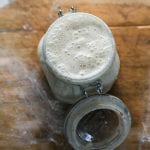
Beginner Sourdough Starter Recipe
- Yield: appx. 240 g (1 cup)
- Category: Sourdough Starter
- Method: 1-Bowl
- Cuisine: American
- Diet: Vegan
Description
Looking for an easy, sourdough starter recipe for beginners? Adapted from my bestselling book Artisan Sourdough Made Simple, follow my no-nonsense guide for practical tips, tricks, and ongoing care- anyone can do it.
Ingredients
Note: Once your starter is established, use it to make my sourdough bread.
- 1x (5lb) bag all purpose flour or bread flour (I use either KAF, Trader Joe’s, or Whole Foods)
- 1/2 cup (60g) whole wheat flour (I use KAF whole wheat)
- Water (preferably warm around 85F )
Tips:
- The overall process typically takes 7 days, if the temperature is warm enough, ideally 75+ F. However, it can take up to 2 weeks or more for a strong starter to become established. Please be patient. Find a warm spot for your starter to rise (see tip in recipe below), and use warm water in your feedings if necessary to give the fermentation a boost.
- Only a small amount of whole wheat flour is used to jumpstart the fermentation process. If you don’t want to commit to a large bag, smaller bags are available in most grocery stores. Alternatively, you can use all purpose flour only.
- You will also need one large 3/4 L jar, or something of similar size (I use this one.).
Instructions
Before you begin: Establish a feeding schedule. In other words, feed your starter at the same time each day. This will establish consistency, which sourdough starters love. Consider feeding your starter in the morning when you wake up.
Day 1: Combine 60 g (1⁄2 cup) of whole wheat flour and 60 g (1⁄4 cup) of warm water in a large jar. Mix with a fork until smooth; the consistency will be thick and pasty. If measuring by volume, add more water to slightly thin out the texture if necessary. Cover with plastic wrap, reusable wax wrap, or a lid and let it rest in a warm spot, about 75-80 F, for 24 hours. Temperature is important.
TIP: Looking for a warm spot? Place your starter on a cookie sheet inside the oven (turned off) with the light on for an hour or two (it can get hot in there, so keep you eye on it!). Center rack is best. You can also use a proofing box set to your desired temperature, or a microwave with the door ajar and light on.
Day 2: Check to see if any bubbles have appeared on the surface. If you don’t see anything, it’s okay. The bubbles might have appeared and dissolved overnight while you were sleeping. You don’t have to do anything else now. Rest the starter for another 24 hours.
TIP: During the creation process, and even after your starter has been established, a dark liquid might appear on the surface and throughout the culture. It has a very stinky smell, similar to rubbing alcohol or gym socks. This liquid is called “hooch” and is an indication that your starter needs to be fed. It’s normal. Any time you see this liquid, it’s best to remove it along with any discolored starter present. However, on Day 2 just leave the hooch alone. You can remove it tomorrow when you start the feedings.
Day 3: Remove and discard approximately half of your starter from the jar (you should have 60 g left). The texture will be very stretchy. Add 60 g (1⁄2 cup) of all-purpose flour and 60 g (1/4 cup) of warm water to the jar. Mix with a fork until smooth. The texture should resemble thick pancake batter or plain yogurt at this point. Cover and let rest in your warm spot for another 24 hours.
As the yeast begins to develop, your starter will rise, and bubbles will form on the surface and throughout the culture. When the starter falls, it’s time to feed it again. TIP: Place a rubber band or piece of masking tape around the jar to measure the starter’s growth as it rises.
At a glance, your overall daily schedule with measurements should look like this:
- Day 1: 60 g flour + 60 g water = 120 g starter
- Day 2: Do nothing
- Day 3: Remove & discard half of the starter/ 60 g starter + 60 g flour + 60 g water = 180 g starter
- Day 4: Remove & discard half of the starter/ 90 g starter + 60 g flour + 60 g water = 210 g starter
- Day 5: Remove & discard half of the starter/ 105 g starter + 60 g flour + 60 g water = 225 g starter
- Day 6: Remove & discard half of the starter/ 112.2 g starter + 60 g flour + 60 g water = 232.5 g starter
- Day 7: Remove & discard half of the starter/ 116.25 g starter + 60 g flour + 60 g water = 236.27 g starter
Wondering if your starter is ready to use?
When your starter is fully active, do the float test. Feed your starter, wait for it to double in size, and then drop a teaspoon of bubbly starter into a jar of water; if it floats to the top it’s ready to use.
Storage Options
If you bake often, store your starter at room temperature (feed it 1x-2x a day to keep it active). If you plan to bake only once in a while, store it in the fridge to preserve its strength (feed it 1x a week). When storing your starter in the fridge, there’s no need to bring it to room temperature first before feeding it. Just give it some flour and water and pop it back in the fridge.
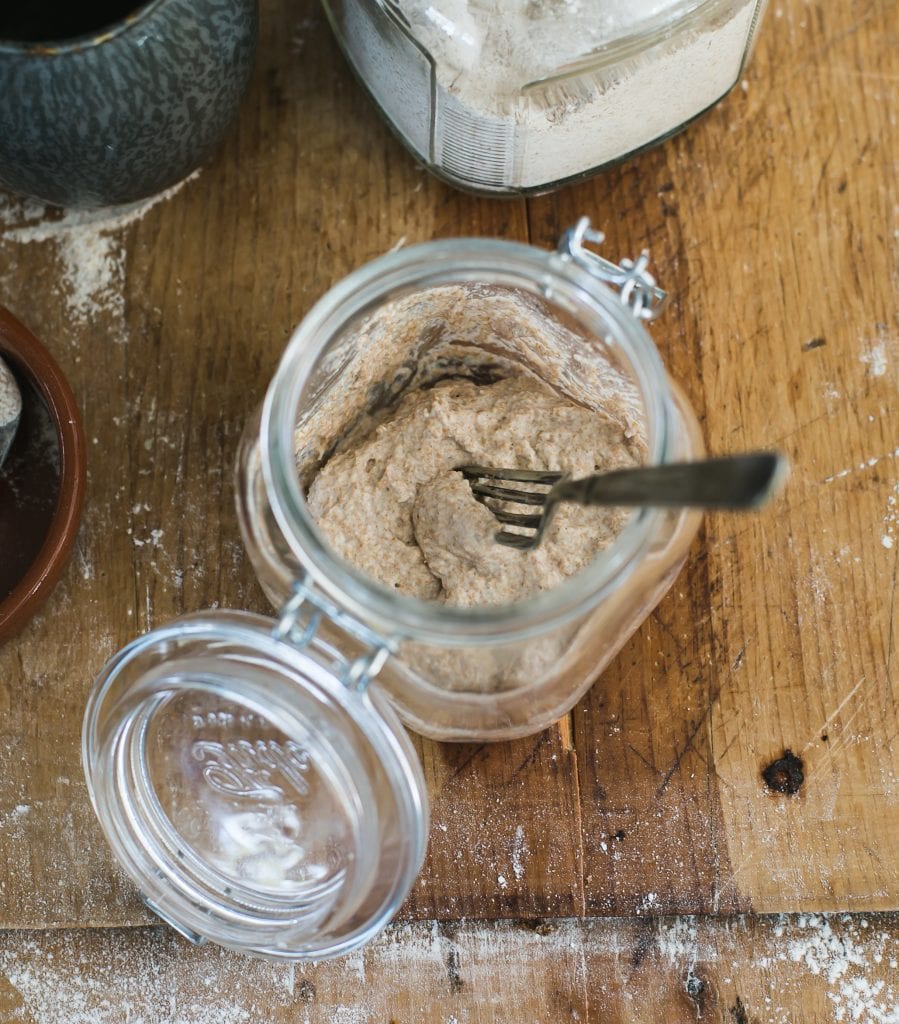
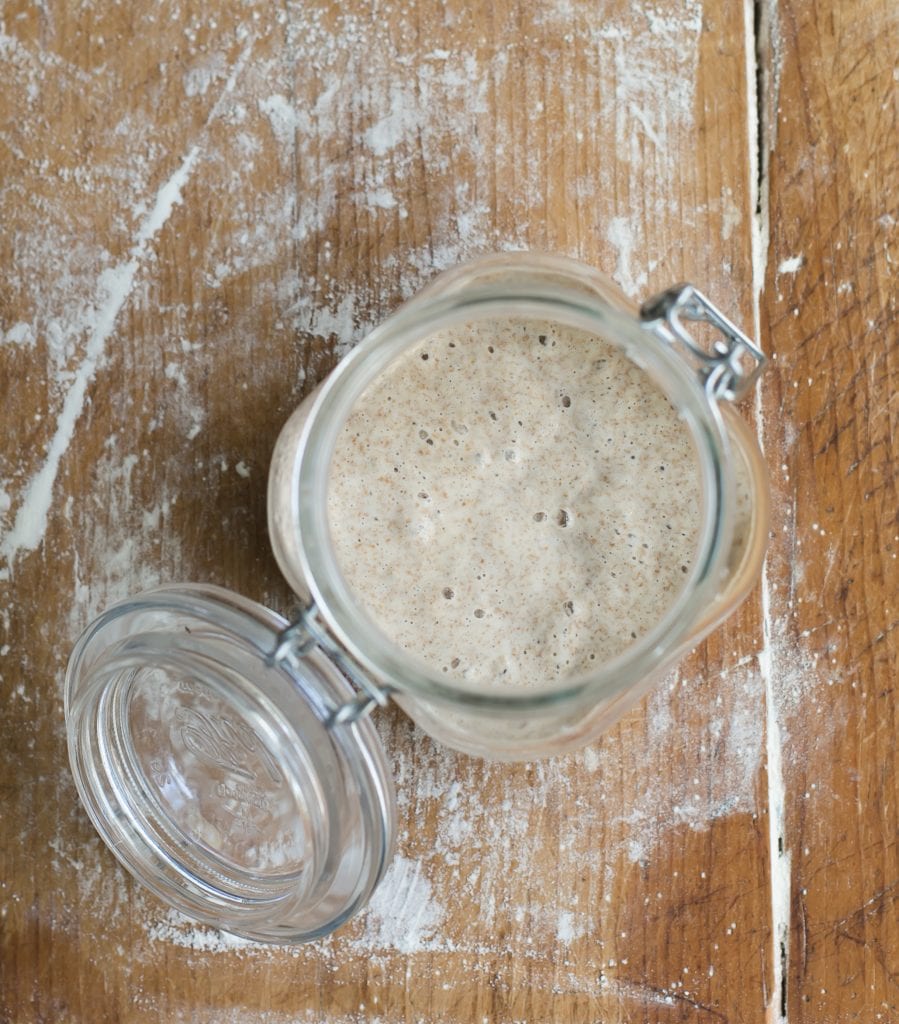
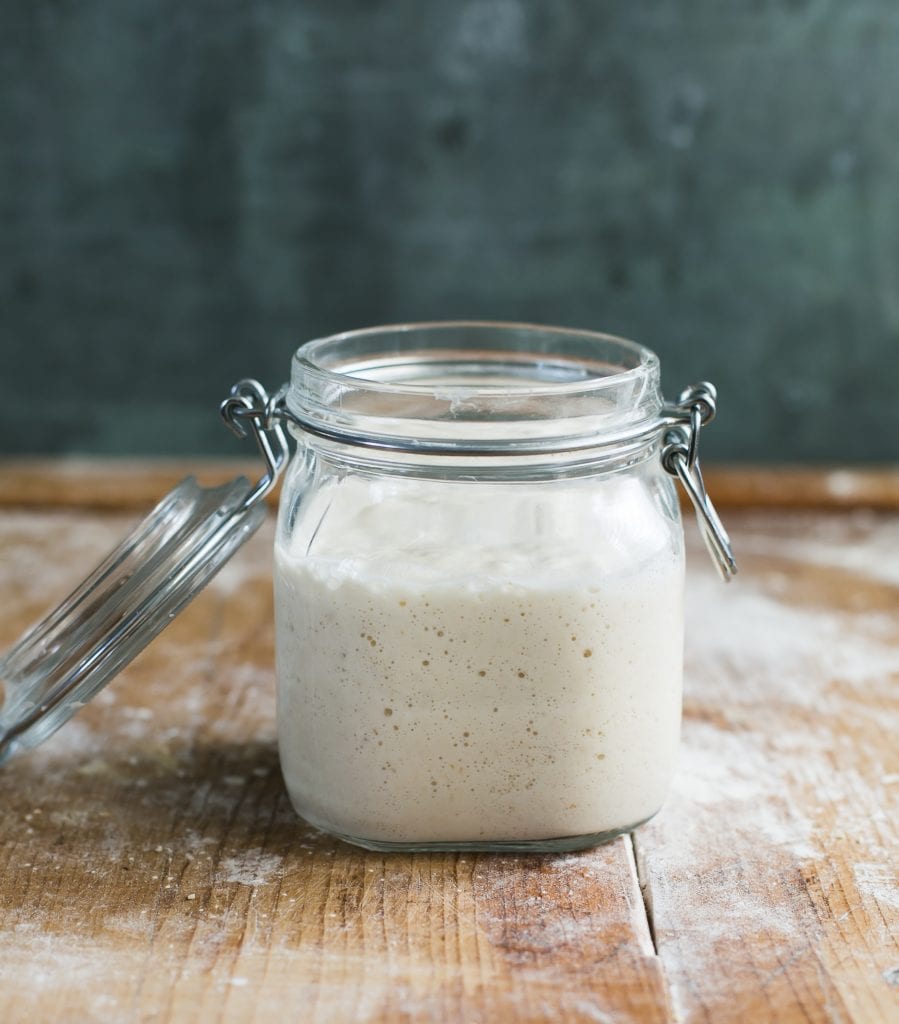
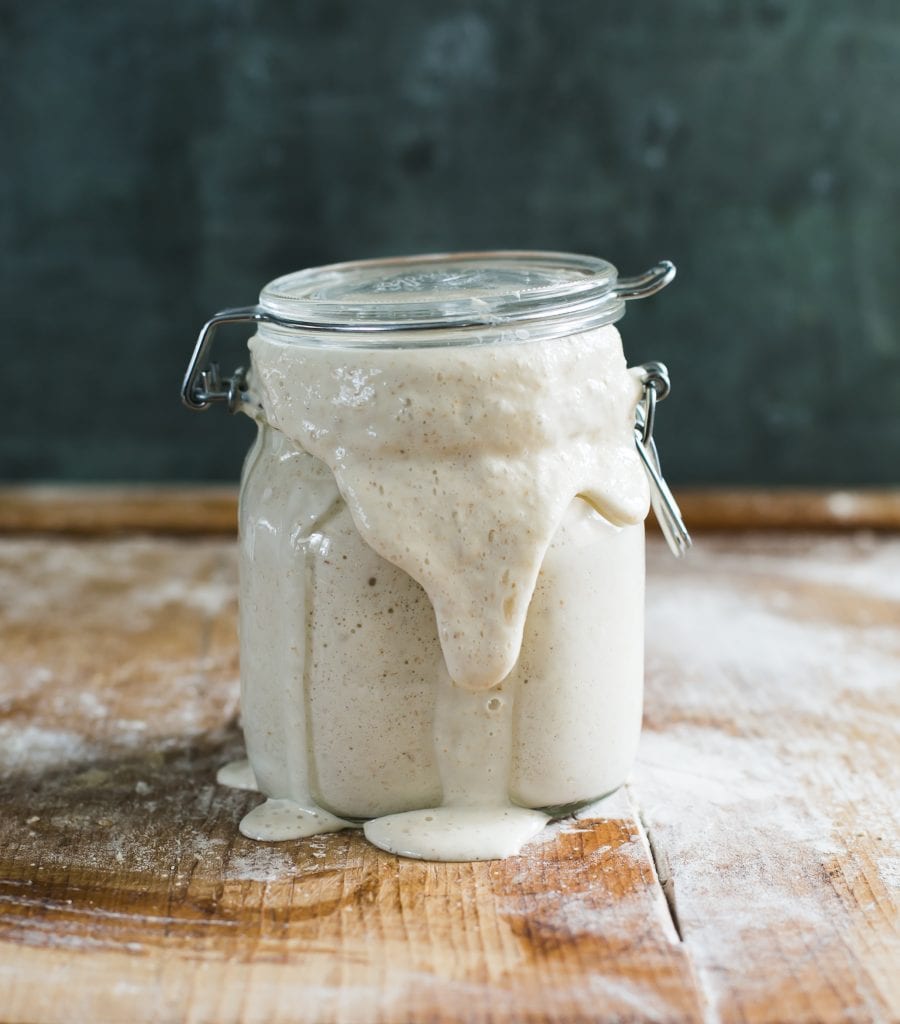
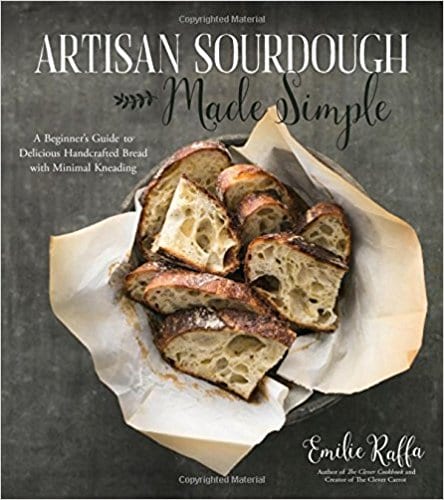

Comments
Betsy says
Why do you discard half of it instead of splitting and doing two starters? Yes, yes I’m a newbie.
Jessica Fedele says
I am curious about that as well! Thanks for asking.
Kaitlyn says
It grows exponentially. If you didn’t discard you would have a ton of starter. Once your starter is established, you can do discard recipes so you aren’t just throwing it out.
William Gilmore says
I tried this recipe twice and both times I got a stiff batch of dough in a jar. It didn’t look anything like yours. What’s wrong???
AV says
If you’re following the recipe 100% and it’s still not working maybe try adding distilled or bottled water? Perhaps the chemicals in your tap water might be an issue. Maybe your house if so warm that the bubbles are happening but are gone by the time you view them?
Good luck! 😊
Emilie Raffa says
Too much flour and not enough water. The starter should only be thick and pasty on Day 2. Are you weighing your ingredients? And what type/brand of flour are you using for the entire process?
Emilie Raffa says
A few reasons. When creating a sourdough starter (for the very first time), you’ll need to discard a portion because “first time” discard is either discolored, smelly, or contains hooch. The acidity levels are totally off and not worth saving to create another starter. It’s just the way it is. The second reason is to control its growth in size. If you don’t discard, your starter will grow exponentially and you won’t know what to do with all of it! With that said: once your starter is up and running, the quality of your discard will be much, much better and can be used to create another starter or incorporated into a variety of sourdough discard recipes. Search my recipe index for plenty of sourdough discard recipe ideas (pancakes are great!).
Kelley Greer says
Do you use filtered water or tap water?
Emilie Raffa says
I use tap water. However, filtered can be used if your tap is not great.
Erin says
Question: what do you do after day 7? Do you go to a 1:1:1 ratio? Does this mean I would use 118 starter 118 flour and 118 water? Or do you pick a 1:1:1 ratio? Like 60 or 80g each? How does that work once it’s been established?
Mariah says
What do you do once the starter is ready? Do you continue feeding it, leave it for future use??
Emilie Raffa says
Yes! Exactly. Follow a 1:1:1 ratio of your choice (i.e. 60 g, 80 g, 100 g etc.) The amount you pick depends on the overall quantity of starter your want to maintain. It can be scaled up or down at anytime. Great question.
Hannah says
Do you use the starter in a recipe and then feed it after? Or do you feed it again right before use?
Carolyn says
Hi, thanks for the recipe and and the attempts to help all of us! I too am a newcomer to this process and tend to over analyze everything…I really want to succeed!
My question is, since I have a cooler home and no real good way to keep the starter in the optimal suggested range, it seems obvious my starter will be slower to respond, ferment and grow. So, when starting the starter, should I still feed it at the “same time everyday”, or feed it when it looks hungry? It will be living in about 66 degrees.
Thank you again.
Cat says
This looks like a winner. One questions, can the recipe be dried? And reconstituted later and still be successful?
Christine says
What temperature is ‘warm’ water for purposes of the sourdough starter? I have scoured the internet and no one will say what temperature is considered ‘warm’…I am on Day 3…so I am hoping to get this right.
ella says
body temp. or luke warm tbh
Jas says
Hi, I’m on day three and it’s gone very watery? The texture isn’t stretchy at all, it was thick when I started on day one. I’m wondering if the temperature is too high, it’s summer and very warm during the day where I am (31 celcius today). Thanks!
Naomi Hovav says
Hey, thanks for the recipe!
There’s a part of the process I don’t understand.
When my starter is active I have about 120g of it, how do I make the bread recipe that says to use 150g of active starter and still keep a starter?
Georgia Pedersen says
I personally would feed it again, without discarding too much of the starter. And then when it is double in size, use it for your sourdough and feed again
Sally G says
I wish I had succeeded. I consider myself a moderately, decent cook – Until now! Not sure what I’ve done wrong? I have followed your instructions to the ‘T’. I am on day 21 tomorrow. We live in FL & the weather has been cooler, so I have been using a lit oven to store my ‘starter project’. I have tried the float test with no success. Help, please!
Kathryn McAllister says
I’m in Day 4, it looks really good lots of bubbles, I’m excited, have never done this before so I’m pleased how it’s turned out, with the simple instructions. Thank You Again🙂
Amanda says
Can I use bread flour from day 3 forward? Or does it have to be AP? I usually keep organic flours, but my AP is non-organic. I’ve read elsewhere that bread flour helps the sourdough maintain and grows stronger because of the higher protein levels. What flour do you recommend I use?
Thank you!
Selena says
Hi! I’m on day 4, I noticed when I was getting rid of half my starter there is a more watery substance on the very bottom of the starter. Is this normal?
Miranda N Luchsinger says
I think I broke my starter. It smells like nail polish remover. Is it salvageable or should I start over?
Georgia Pedersen says
I would continue to feed it until 7days and see then. If it’s mouldy etc you will see it turn pink/green spots.
Christine Ugarenko says
Easy to follow Just on day 3. Hoping for beautiful loaves of sourdough bread.
Sydney says
I’m a little confused reading some comments, just to confirm I’m understanding correctly- so days 4-7 after having a really active and bubbly starter we’re then removing half so I should measure the starter before removing half so I can then replace that half with the 1:1:1 ratio?
Michelle says
Hi,
If I keep it on my counter do I discard every day and then feed? My kids are going through loaves of sour dough like crazy right now and so need to bake more 😂
Thank you!
Ed says
The light on in the microwave did the trick. 79 degrees F. Starter doubled on day 1 with lots of bubbles. Now I have a new dependent in the home.
Cherokee says
Hi! I’m on day 2 and my starter is doubled and lots of bubbles. Should I leave it alone until tomorrow or should I feed it ?
Steph says
Worked fabulous. I am on day 7 my starter has risen every day to double the previous days size.
Carole says
My starter rises more then double for the 1st time and is full of bubbles. What now? 🤷🏼♀️ do I keep discrding and feeding? How often those it need to rise before I can start using it? (Fyi this as been 3 1/2 weeks process, It was the best surprise this morning to see my starter very active)
Lindsey D says
Howdy from Texas! I’m attempting my first ever “starter”, wish me luck. When I put it in the fridge, do I take 1/2 out when feeding it?
Emilie Raffa says
Hi there! Yes. Remove from the fridge and discard 1/2. Don’t worry about being exact every time. The goal is to remove “some” to balance out and refresh the acidity levels.
Amy says
Started yesterday and today the starter is super thick and dry (like it will stay separated and feels more like a firm dough). I added some water to thin it out. Or should I just start all over
Emilie Raffa says
Hi Amy! The starter is supposed to be very thick and pasty on Day 2. This is normal. Water is not necessary at this stage, but don’t worry- you didn’t make a mistake. Continue with the instructions as written, taking note if the consistency seems to thin due to the added water. You can always add a touch of flour to balance it out if needed. You’re looking for a thick, batter like consistency from Day 3 onwards.
Taylor says
On day 6 of making this starter. The starter has bubbles throughout and on top and is rising a lot. It smells like nail polish remover though. Should I increase feedings to twice per day? If so, should I follow the same feeding instructions/amounts? I read online that it could be hungry. Thank you!
Emilie Raffa says
Hi there! Sounds like your starter is active. Congrats! Regarding the aroma, you can increase the to feeding to 2x per day if you want. Alternatively, discard a larger portion of starter before your next feeding. Both options will refresh/balance out the acidity levels, which will get you a fresher, more fruity smell.
Taylor says
Thank you for your reply! I did the float test and the starter floated. Does this mean I can start using it? Or do I need to get rid of the nail polish smell first.
Emilie Raffa says
Perfect. It’s OK to use! Your starter will always have a slight sour smell. If it’s really bad (you’ll know) then just feed it one or two times before using it to refresh the acidity levels.
Erin says
This is amazing and it worked so well. I named mine “night of the living Bread”. The naming process was really the best part.
Emilie Raffa says
Love love love this name! Thanks for sharing Erin :)
Ashley says
Can any flour be substituted for all purpose flour? Thank you and so excited started.
Emilie Raffa says
Hi there! I would use bread flour for best results (then you can use the rest of the flour to bake with!). Bread flour has great enzymes which sourdough starters love.
Abi says
Should I still feed using 60g each of water and flour if I’m going past day 7? I’m on day 8 and my starter is clearly not ready yet so I’m wondering if it needs larger feeds as the volume of starter grows or not? I know you recommend 1:1:1 once it’s established, but during this phase what would you recommend past day 7?
Emilie Raffa says
Hello! You can do the 1:1:1 now. This will keep it from growing any larger (for reference, the initial ratio you were following build the total quantity to approximately 1 cup). Try to feed it at the same time each day (morning is easiest to remember), increase the flour if the consistency is too thin, and rest in a warm spot.
Christine says
When using the starter for recipes, including discard recipes, should I replace the same amount I use from the starter in equal amounts? So if I use 1 cup of starter, should I replace it with 1/2 cup flour and 1/2 cup water?
Emilie Raffa says
Hi Christine! Yes, you can do that. There’s some flexibility with the amount too- it really depends on the total quantity of starter you want to maintain.
Christine says
Good to know about flexibility. If I want to maintain a higher amount of starter, would it be ok to feed it without dumping some? Or add more than I use to feed it? This is my first time making sourdough and I’d like to maintain a little more than what I have now. I appreciate your input, thanks!
Tylet says
I rest my starter on a temperature controlled heating pad meant for plant seedlings, set at 75F. I noticed the starter really rose a lot the first day and definite signs of fermentations. This is okay right? I want to make sure I’m not overdoing the heat.
Emilie Raffa says
Yes! Totally fine. Starters love warmth and their ideal resting temperature is 75-78 F. I’ve never used a seed mat before, but I’ve head from plenty of sourdough bakers who use them regularly with great success to keep their starters happy.
Laura says
Hi there!
I started my started yesterday morning. I’ve been keeping it in the oven because my house is chilly (usually only about 66 inside) but my question is. I looked at my starter this morning, didn’t see any bubble but I did see there was some hooch that formed. Also the consistency is still pretty thick? Is that normal?
Also, if I’m keeping it in the oven since my counters are so cold, how long should I keep the light on in the oven? Should I just continuously keep it in the oven until it’s done proofing then eventually move it to the fridge?
This is my first time and I think I’m over thinking this haha
Thank you!
Emilie Raffa says
Hi there! Hooch is normal. It will be normal now and for ongoing feedings. It’s just a sign that your starter is ready to be fed. On day 2, yes: the consistency will be very thick. There is no set time to keep it in the oven with the light on- you have to monitor it. Every oven light is different. The biggest thing to look out for if that you don’t want your oven light to get too hot near the starter. As an alternative, make a hot water bath instead. To do so: fill a small bowl with hot tap water and place your sourdough starter jar inside (do not submerge). Small bubbles will form at the base of the jar and work their way upwards. Change out the water every time you can remember- it will get cold. I use it to water my plants!
Daphne says
Yes I did very simple.I started some sourdough starter but did not discard half I just kept feeding it everyday 1/2 flour 1/2 warm waterI did that for three days then I started seeing liquid on the bottom of the jar I put it in the fridge.I started to make some sourdough bread but my
Sourdough dough is stinking.I am going to start all over again following your instructions.
Emilie Raffa says
Hi there! Sounds like your original sourdough starter wasn’t active when used to make bread dough. This is OK. It’s how we learn. After feeding it, when it’s vibrant, strong, bubbly, and double in size it will be optimal for making bread. The process takes time so patience is key.
Bailey says
So… when it’s time to bake with the active starter, do you discard, feed, then use it in the recipe? How long do you wait after feeding to use it?
Veronica Rodriguez Rosas says
Im a bit confused. I dont close the lid on the jar while starting?
Emilie Raffa says
I close the lid. If you prefer to rest the lid on top of the jar (to still keep it covered but not super air tight) you can do that too.
Abi says
Hi! 2 questions.
I am on day 3 of establishing my starter and I am hoping I didn’t just make a mistake. I noticed some hooch in a layer in the middle of my jar and I mixed it in instead of pouring it out. Is this okay? Smells very strongly of rubbing alcohol. There are a lot of bubbles throughout the mixture and on the surface and it is rising well. I am also wondering if the container I’m using is okay. I am using a large mason jar, but am wondering if I should be screwing the lid on tight or just resting the lid on top so as to allow the starter to “breathe”?
I threw out my first starter a few days ago and this is my second attempt, so I really hope I didn’t screw this one up already! My first starter made a decent loaf following your recipe (albeit a bit flat/dense – I don’t think my starter was quite ready and I also think I may have over-proofed the dough), but the flavor was great and I am excited to try again with a hopefully better starter. Thank you so much for your help!
Emilie Raffa says
Hi there! Yes: this is OK. Ideally, you want to discard hooch as it’s not optimal for your starter for obvious reasons (it smells). But in short: no harm was done. This is why discarding a portion of your starter is so important; it rebalances the acidity levels making it look and smell fresh. The taste will be different too. As for the jar, a mason jar is perfectly fine to use. The lid can be screwed on tight to build up pressure more quickly. Just keep and eye on it so it doesn’t explode. Alternatively, you can rest the lid on top. It won’t be airtight, but the jar will still be covered. In my experience, your starter will receive plenty of air when initially fed. However, some bakers prefer to leave the surface completely exposed- I don’t do this. Just preference. Finally, patience is the SECRET to sourdough. Period. The entire process takes time and trust. So give you starter the time is needs to build and grow before using it. The investment you make now will yield better results later on.
Mandy says
Started my starter today and just happened to look at my flour and noticed it’s bleached…ugh! Should I just restart you think? Thanks
Emilie Raffa says
Hi Mandy! How’s your starter going? I’m wondering if you have continued with the bleached flour? Some bakers do have luck using it, others don’t. If it’s working, don’t throw out your starter- just switch to feeding with unbleached flour when you can.
Mandy says
Hi Emilie,
Thank you for getting back to me! I actually just restarted it with whole wheat and then on day 3 started feeding it with unbleached flour. I’m very happy to say that today is day 7 and it’s absolutely beautiful…bubbly, marshmallow like texture, and smells fruity. On day 4 I think I took the discard and fed it so I had 2 starters that have turned out great! Thank you for all of your tips and tricks and in the beginning I was unsure ( I live in Phoenix and did the microwave trick), but I remained patient and it has turned out perfect! Thank you so very much
Emilie Raffa says
Excellent. Excellent. Excellent. I’m thrilled to hear this! Patience is key- it’s the secret to sourdough success :)
malia says
I’m on day 11 and I think it’s ready to refrigerate and feed once a week like you said. Do I still discard half and then feed like I have been or do I just feed it? TIA 😊
Miranda says
Hello,
Thank you so much this is an extremely informative recipe and I look forward to trying it. I plan on making 16 starters for gifts this holiday season. Can I use the discard portion to double the starters to cut down a little bit on sheer amount of flour? Also is the transferring into a fresh clean jar imperative for a healthy long lasting sourdough starter? Thank you so much and I hope to hear back
Emilie Raffa says
Wow! 16 starters! You are my hero. You can use the discard to make new starters, but only if the quality is OK. Meaning, if it’s dark, discolored and smelly don’t use it. You’ll waste more flour feeding it to refresh the acidity levels than anything else. Otherwise, you’re good to go. With regards to transferring the starter to a new jar, this is just to keep the conditions clean. Normally, after 7+ days of feeding a starter in the same jar, it can get crusty. Jus use your judgement here and for ongoing feedings.
Shelley says
Thank you for this. My first loaf turned out heavenly!
Emilie Raffa says
You’re very welcome Shelley! xx
Nurul says
Hi im from Malaysia. I’ve been studying about this starter a few weeks already and this is the best recipe, best info and tips that i get so far. Thank you so much for your effort for this beautiful site. I can’t wait to read more ❤️
Emilie Raffa says
You’re very welcome, Nurul. Thank you for taking the time to comment. Wishing you well on your sourdough journey.
Renee says
Hello, thanks for this tutorial. Not sure what I’m doing by wrong. It’s been 3 weeks and I’ve been feeding the starter everyday per the instructions; 1/2 cup AP flour 1/4 cup warmed filtered water. I get little bubbles, so know it’s alive, but it’s not bulking up or doubling in size. Any advice?
Emilie Raffa says
Starters need time, temperature (ideally 75+ F), consistency and patience. The fact that your starter shows some activity is a good sign. What is the consistency? Thick or watery? And are you feeding it at the same time each day? If it’s too thin, I recommend cutting back on the water to achieve a thicker consistency (do not get caught up on exact amounts) and/or switching to bread flour to boost the enzyme activity. Try feeding it at the same time each day- in the morning is the easiest. And as always, find a warm spot for it to rest when stored at room temperature.
Renee says
It starts off thick when I feed it, but thins out when i go to feed it again. i feed it every night before i go to bed. i store it under a halogen lamp to keep it as warm as possible without running up the light bill.
Guin says
My starter has bubbles but is not doubling in size after 7 days despite following instructions. I put a rubber band around the jar to track growth and it’s stayed about the same height after every feeding. What might I be doing wrong?
Emilie Raffa says
Hi Guin! You’re not doing anything wrong. It’s normal for a sourdough starter to need more time to become established. Another reader asked a similar question- see my (copy & paste) response below. Additionally, check out this article for further troubleshooting:
https://www.theclevercarrot.com/2018/03/troubleshooting-your-sourdough-starter/
Starters need time, temperature (ideally 75+ F), consistency and patience. The fact that your starter shows some activity is a good sign. What is the consistency? Thick or watery? And are you feeding it at the same time each day? If it’s too thin, I recommend cutting back on the water to achieve a thicker consistency (do not get caught up on exact amounts) and/or switching to bread flour to boost the enzyme activity. Try feeding it at the same time each day- in the morning is the easiest. And as always, find a warm spot for it to rest when stored at room temperature.
Oggy says
I started this yesterday and it’s going amazing! I got beautiful bubbles by 24 hours, the smell, the hooch. Perfect. Maybe cos I live in Nigeria where the weather is pretty hot. Every spot is a warm spot. Sour dough bread is not a thing here and I’ve never even eaten it but as an avid baker (hobby), I’ve been curious. So glad found this website. I LOVE this process.
Emilie Raffa says
This is excellent feedback, thank you! Yes: sourdough loves warmth. Your starter will rise and fall quickly. So will the dough! You can always chill the dough at any point to control the rise as needed.
Robert says
Hello
Thank you for this recipe. I tried last week with no success. I’m not sure if the jar suppose to be sealed or loosely covered?
Thank you
Sincerely
Robert
Emilie Raffa says
Hi Robert! I cover my jar. The pressure builds up faster. Just keep an eye on your starter as it continues to rise; you don’t want the jar to explode.
Dana Mae says
Hi there. I grew up on sourdough and since I lost my grandmother we haven’t gotten back to sourdough pancakes. My youngest loves them and my oldest would love her own start. I used to feed the one my grandma kept but I’ve never made my own. Can I use a gallon glass jar and double the start so I can send some home with my oldest daughter and keep some here at home for my youngest? Thanks in advance!
Emilie Raffa says
Hi there! Yes, you can. However, it might be more efficient to make a single starter first. Once it’s established, feed it everyday (without discarding) to reach your desired quantity. Then portion into containers and distribute.
Patty Brown says
Thank you for this post.
It seems wasteful though to discard the dough…
1. Why not transfer to a larger container and double the flour and water at feeding times?
2. Wouldn’t you get the same results?
3. Can the excess be refrigerated for future use instead of refeeding the small batch?
Also, a short video walking through the steps and showing the actual results would help those who are visual learners.
Thanks again.
Emilie Raffa says
Hi Patty! You’re very welcome. When first creating a sourdough starter, it’s necessary to discard some of it to refresh and balance out the acidity levels. You’re in the process of cultivating bacteria- it needs to be fresh. Plus, if you do not discard, your starter will grow exponentially in size! Once it’s established however, feel free to modify the process to avoid waste. For example, sourdough discard can be used to make additional sourdough recipes like pancakes and muffins (check out my recipe section for ideas). Or, keep your main starter jar in the fridge, and only take out what you need to feed for your recipe (i.e. if you need 75g active starter for a sourdough bread recipe, take out 25 g of starter from the fridge and feed it with 25 g flour + 25 g water. You’ll have nothing leftover.
Jen Grenell says
First all, thank you for the instructions on how to get started. I’m a first timer, and about to start the journey of making my first sourdough starter.
Question… After the 7 day process, when you say “replenish what’s left”, do you feed with the same instructions detailed in day 3 where you remove and discard about half of your starter, and feed with 60 grams of all purpose flour and 60 grams of warm water, and then mix with a fork til smooth?
Many thanks for your great content!
Emilie Raffa says
Hi there! Once your starter is established, feed your starter following a 1:1:1 ratio. So for example, if you have 25 g of starter in the jar, feed it with 25 g of flour and 25 g of water. It doesn’t have to be 60 g. You’re matching the flour and water quantities to the amount of starter you have. More detailed info here: https://www.theclevercarrot.com/2021/01/feeding-sourdough-starter-my-best-tips-tricks/
Titas Saha says
Even after day 8, my starter doesn’t have enough bubbles. Still after every feeding its rising and doubling itself.. but not sure if the process is working, since it still not bubbly. Please help.
Emilie Raffa says
Hi there! This is normal. The process can take up to 2 weeks or more. Here’s why: starters need time, temperature (ideally 75+ F), consistency and patience. Try reducing the water to achieve a thicker consistency (do not get caught up on exact amounts) and/or switching to bread flour to boost the enzyme activity. Feed it at the same time each day- in the morning is the easiest. And as always, find a warm spot for it to rest when stored at room temperature. More info here:
https://www.theclevercarrot.com/2018/03/troubleshooting-your-sourdough-starter/
Pearl says
Here you remove progressively more (by weight) of the starter and then feed 60g each of flour and water, but in another post you recommended doing a 1:1:1 feeding ratio. Is that only for after the starter is good and established? I was doing remove half and add 60g water and 60g flour, but on day 4 it stayed flat after bubbling and growing like crazy on day 3. Today is day 5 and I did a 1:1:1 ratio today. I’m hoping I haven’t totally ruined it. Which is correct during the beginning phase, where we’re establishing the starter? Thank you in advance.
Terry says
I noticed this too, after realizing after a week that I’d been removing the same amount of starter that I was adding in flour and water, and wondering why my volume kept increasing. To correct this I removed half the starter and added the previous amounts of flour and water, but then wondered if I should have added more to keep pace with the volume of starter. Like Pearl I noticed that these amounts do not increase, so that the ratios are not 1:1:1 but something less.
Emilie Raffa says
Correct. Follow the ratio in this post to create/establish a sourdough starter. This specific ratio builds up the total quantity to roughly 1 cup. Once it’s established, then you can switch to the 1:1:1 ratio for ongoing feedings. You didn’t ruin your starter. The amounts don’t have to be exact. You’re actually looking to maintain the right consistency (thick pancake-like batter) since your starter will look different on different days. In your case, adjust with more/less flour and water as needed so it looks right. Then continue.
Hali says
Hi! Can I use a 1 L jar? Would that make a difference?
Emilie Raffa says
Yes! That’s totally fine.
Jenny says
So if you opt to put it in your oven or microwave with the light on for 1 to 2 hours, then what? Does it have to stay warm for the rest of the 22-23 hours? Trying to find a good, warm spot and not sure how long it needs to stay at that 75-80° sweet spot.
Emilie Raffa says
Sourdough starters will only maintain a specific temperature if they are consistently stored in a proofing box. Most of us don’t have proofing boxes. So it’s OK if the temperature decreases. Just keep it in a warm spot for your desired length of time to give it a boost. Note how long it takes to rise and make adjustments from there.
Terry says
What if I forgot to remove any starter on Day 3, and just added the flour and water?
Emilie Raffa says
It’s OK! The process is forgiving. Just remove a portion before the next feeding to catch up.
Kelsey Hammerschmidt says
I misunderstood the directions and have only been removing 60g of starter every day instead of removing half but still adding 60g flour and 60g water. Have I ruined my starter? Do I need to start over?
Emilie Raffa says
Not at all! You’re just following a specific ratio in the beginning to build up your starter to approximately one cup. It doesn’t have to be 100% exact. At this point, simply adjust your feeding schedule/quantities and continue.